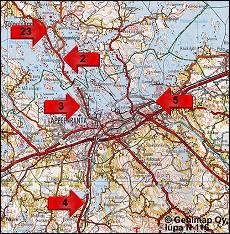
|
|
Site map: Sites 2-5
|
4. Kauskila cemetery in Lappeenranta, from the time of the Crusades and the Early Middle Ages
It is believed that a church or chapel and a burial ground were once located on Kauskila's Kappelinmäki Hill in the old Lappee parish, today's Lappeenranta. An old road crosses Kappelinmäki Hill. In the 1500s it led from Vyborg to Savo and Häme. It was probably not until the end of the 1500s that Lappeenranta became a more important centre than Kauskila. We learned more about the site in 1951 when a road was straightened on the hill: cutting open the road exposed jewelry that suggested a prehistoric woman's grave.
Archaeological studies conducted on the site revealed a burial ground dating from the 1100s to 1500s. The Kauskila burial ground is considered Karelian on the basis of its artefacts, but objects found also tell of Swedish and Baltic contacts. The most noteworthy of the findings include women's oval tortoise brooches used for fastening clothing, horseshoe clasps, ear spoons, parts of chains, and bronze and glass beads. Iron axes, belt parts, knives, fire flints, and coins were found in men's graves. The most interesting object is a small silver cross pendant. It appears to be of Byzantine origin. The oldest graves in the cemetery are from the time of the Crusades (1100-1300 A.D.). The changeover to the Christian way of burial without objects began in the 1300s. Two silver Swedish coins found in 1573 suggest that the burial ground was still in use at the end of the 1500s.
At this point almost 200 graves have been found in the burial ground. Studies have also produced indications of a chapel's location. Studies were conducted in the cemetery in 1953, 1997, and 1999-2001. Research continues.
Driving directions: Take Vaalimantie road (no. 387) from Lappeenranta and drive about 6 km. Turn right on Kauskilantie road and continue about one kilometre. The site is immediately on the left side of the road. Cars or a bus can park at the widening of the road.
